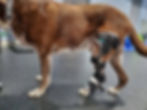Braces and Devices
When your pet is limping due to discomfort caused by an injury or instability, we understand the impact this has not only to the quality of life of your pet, but also to your family. Our sole focus is on the design and support of our custom animal orthotics and prosthetics to restore your pet’s mobility.



Braces and Prosthetics

Innovative Biomechanics of Our Dog Knee Braces
When the canine stifle joint presents with a partial or complete rupture of the CCL (canine ACL tear), the tibia is unrestrained and cranial tibial thrust results. This cranial (forward) thrust of the tibia creates instability of the stifle/knee joint, which can lead to your dog limping. The stifle orthosis (dog knee brace) creates a biomechanical support that stabilizes the rear leg by mechanically coupling the femur and tibia together through the hinges placed across the stifle joint. The hinges that couple the femur with the tibia accomplish this by joining the upper femoral shell with the Tibial shell while allowing your pet to enjoy supported motion to sit, stand, walk, and play.
Dog Knee Brace State-of-the-Art Fabrication
Your dog’s ACL knee brace is manufactured in our state of the art manufacturing center through a digitalizing process of the fiberglass impression. The impression is turned into a 3D model that is digitally sculpted to create your dog’s ACL brace shape. The carved model is vacuum formed with advanced plastics to create the custom made canine cruciate brace. Once the soft medical grade foam liner, adjustable and replaceable straps and pads are added, the device is ready for delivery.
Features:
- Innovative cruciate/knee brace design providing increased support and comfort to your dog’s leg
- Advanced biomechanics creating “force coupling” to stabilize your dog’s ACL injury or tear
- Researched and tested (ACORN Stifle Study, CSU Stifle Study)
- Tibial control strap restricts cranial tibial thrust
- Adjustable strapping accommodates muscle mass return
- Polycentric mechanical hinges replicate the complex motion of your dog’s knee (stifle) joint

Innovative Biomechanics of Our Dog Elbow Braces
The canine elbow is a unique joint susceptible to injury and instability. Elbow joint arthritis, medial compartment syndrome, elbow valgus, elbow varus, post-op arthrodesis, and DJD presentations are common orthopedic injuries that can affect your pet’s elbow joint and cause pain and lameness. The OrthoPaws Elbow Brace stabilizes and supports your dog’s elbow joint by creating a 3-Point Corrective System. This advanced biomechanical support system stabilizes your dog’s elbow joint by applying a corrective force location supporting the elbow joint and two counter force locations that complete the dynamic mechanical environment acting within the OrthoPaws Elbow Brace system.
Dog Elbow Brace State-of-the-Art Fabrication
Your dog’s elbow brace is manufactured in our state-of-the-art manufacturing center through a digitizing process of the fiberglass impression. The impression is turned into a 3D model that is digitally sculpted to create your dog’s elbow brace shape. The carved model is vacuum formed with advanced plastics to create the custom made brace. Once the soft medical grade foam liner, adjustable and replaceable straps and pads are added, the device is ready for delivery.

Innovative Biomechanics of Our Dog Wrist (Carpus) Braces
The canine wrist (carpus) is a complex joint susceptible to injury and instability. Carpal hyperextension, carpus valgus, carpus varus, post-op arthrodesis, and neurological presentations are common orthopedic injuries that can affect your pet’s wrist joint and cause pain and lameness. The OrthoPaws Carpus Brace stabilizes your dog’s wrist joint by creating a 3-Point Corrective System. This advanced biomechanical support system stabilizes your dogs carpus joint by applying a corrective force location supporting the carpus joint and two counter force locations that complete the dynamic mechanical environment acting within the OrthoPaws Carpus Brace system.
Dog Wrist (Carpus) Brace State-of-the-Art Fabrication
Your dog’s wrist brace is manufactured in our state of the art manufacturing center through a digitalizing process of the fiberglass impression. The impression is turned into a 3D model that is digitally sculpted to create your dogs carpus brace shape. The carved model is vacuum formed with advanced plastics to create the custom made brace. Once the soft medical grade foam liner, adjustable and replaceable straps and pads are added, the device is ready for delivery.

Innovative Biomechanics of Our Dog Ankle (Tarsus) Braces
The canine ankle (tarsus) is a unique joint susceptible to injury and instability. Tarsal plantigrade collapse, tarsal valgus, tarsal varus, post-op arthrodesis, and neurological presentations are common orthopedic injuries that can affect your pet’s ankle joint and cause pain and lameness. The OrthoPaws Tarsus Brace stabilizes your dog’s ankle joint by creating a 3-Point Corrective System. This advanced biomechanical support system stabilizes your dog’s tarsus joint by applying a corrective force location supporting the tarsus joint and two counter force locations that complete the dynamic mechanical environment acting within the OrthoPaws Tarsus Brace system.
Dog Ankle (Tarsus) Brace State-of-the-Art Fabrication
Your dog’s ankle brace is manufactured in our state-of-the-art manufacturing center through a digitizing process of the fiberglass impression. The impression is turned into a 3D model that is digitally sculpted to create your dog’s tarsus brace shape. The carved model is vacuum formed with advanced plastics to create the custom made brace. Once the soft medical grade foam liner, adjustable and replaceable straps and pads are added, the device is ready for delivery

An OrthoPaws Forelimb/Front Leg or Hindlimb Prosthesis (animal prosthetic) can be a great solution providing mobility and restoration of your pet’s comfort and biomechanics. The old saying that a 3-legged dog does fine has been disproven through advanced research at Colorado State University among other research facilities. 4-legged animals do better and suffer less compensatory problems than their 3-legged friends.
There are many reasons why a pet presents with a missing limb including trauma, congenital deformity, or related orthopedic and oncological issues. Regardless of the reason, OrthoPaws fabricates a custom state-of-the-art prosthesis for each animal’s specific needs.
OrthoPaws will evaluate the animal’s residual limb, patient goals, and medical history to determine if the patient is an appropriate candidate for our innovative prosthetic solutions. Considerations for candidacy include amount of remaining limb, condition of remaining anatomical joints, condition of the skin along the end of the remaining limb, and evaluation of the radiographs (x-rays) of the limb.
Through the appropriate application and use of an OrthoPaws Prosthetics (animal prosthetics), coupled with rehabilitation therapy, your pet can regain lost quality of life, mobility, comfort, and function.
Adaptive Devices

The OrthoPaws Toe-Up Device assists with increasing flexion of the tarsus (hock) while also keeping the hind paw in a corrected normal standing position.
** All OrthoPaws Toe-Up devices must be purchased with a boot.
If your dog is limping or knuckling at the hind limb and paw, this can sometimes indicate a neurological condition. Some causes of this could be but are not limited to: degenerative myelopathy, spinal trauma, sciatic nerve injury, etc.
Through the appropriate application and use of an OrthoPaws Toe-Up Device and boot, coupled with rehabilitation therapy, your pet can regain lost quality of life, mobility, comfort, and function.
Among the many custom pet braces and prosthetics OrthoPaws fabricates, we also provide “adaptive devices” to support your dog’s mobility. In some cases, you may notice your dog limping and knuckling at the hind limb and paw. This can sometimes indicate a neurological condition. Some causes of this could be but are not limited to: degenerative myelopathy, spinal trauma, sciatic nerve injury, etc. The Toe-Up Device assists with increasing flexion of the tarsus (hock) while also keeping the hind paw in a corrected normal standing position.
Through the appropriate application and use of an OrthoPaws Toe-Up Device, coupled with rehabilitation therapy, your pet can regain lost quality of life, mobility, comfort, and function.

An OrthoPaws Hobble Vest is used for medial shoulder instability. The OrthoPaws Hobble Vest prevents the forelimbs from abducting or moving away from the patient’s midline. These injuries are typically treated in conjunction with restricted activity, arthoscopy, shockwave therapy, or laser therapy. The use of professional rehabilitation has been proven to significantly improve patient recovery.
OrthoPaws Hobble Vest is a specialized dog brace (or vest) that can be used to help support and stabilize dog’s with medial shoulder instabilities. Medial shoulder instabilities in dogs are similar to a rotator cuff injury in human’s. These types of injuries typically present with your dog presenting with minor limping, to almost non-weight bearing. Patient’s with medial shoulder instabilities will typically show unwillingness to make tight turns.
A Hobble Vest provides support to your dog’s leg(s) with medial shoulder instabilities. These types of injuries are commonly a result of an injury of the medial glenohumeral ligament and can be the result of a strain and/or tear. Shoulder injuries can present with your dog showing lameness and can range from moderate to severe. These injuries typically become significantly worse after extended exercise. Medial shoulder instabilities often occur in sporting and athletic dogs, and can sometimes occur in older dogs who slip when trying to get up from a slick floor. Medial shoulder injuries are often the result of repeated stress to the glenohumeral ligament.
Patients with medial shoulder instabilities typically present with decreased mobility and lameness. Medial shoulder instabilities are diagnosed by your Veterinarian through skilled manipulation (often under sedation) and are required to rule out a more common injury to a thoracic limb.
A Hobble Vest used for a medial shoulder instability prevent the forelimbs from abducting or moving away from the patient’s midline. These injuries are typically treated in conjunction with restricted activity, arthoscopy, shockwave therapy, or laser therapy. The use of the vest, coupled with guided rehabilitation therapy, has proven to significantly improve patient recovery.




